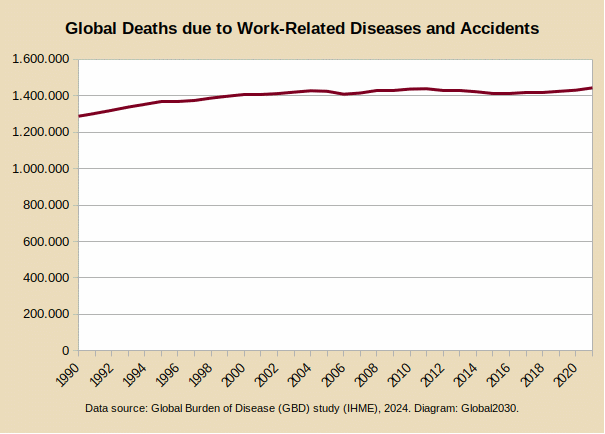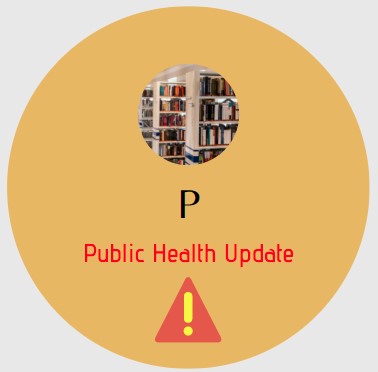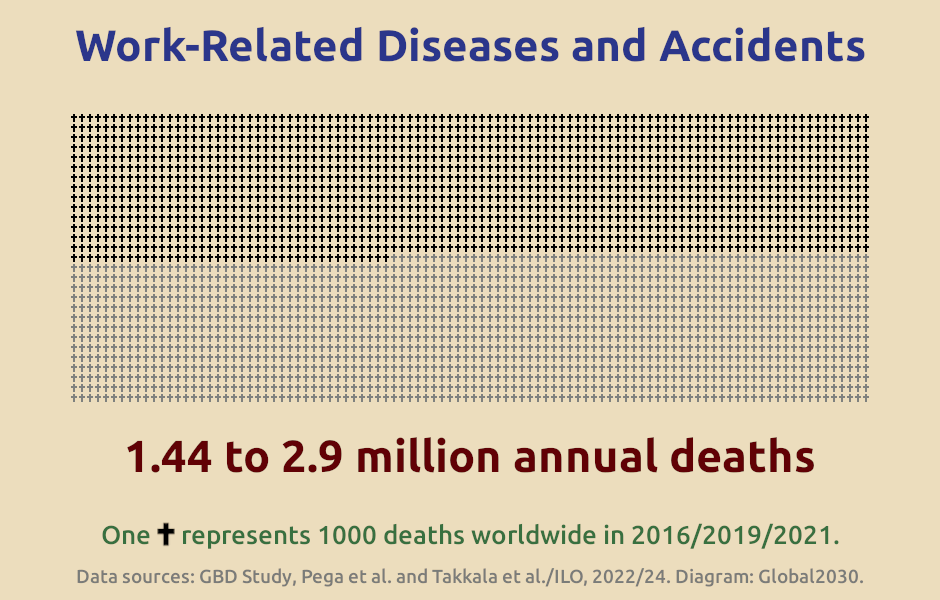I’m excited to share that I’ve just wrapped up a rewarding experience as a guest editor - together with my colleague Anne Saber - for a special issue on firefighter’s exposures and health risks, published in the journal Toxics. The issue features 11 articles covering a wide range of research topics, with valuable contributions from dedicated researchers around the world. Check it out here:
https://www.mdpi.com/2305-6304/13/5/343
https://www.mdpi.com/journal/toxics/special_issues/69CL5V047X
#OccupationalHealth
Today is World Day for Safety and Health at Work!
An estimated 1⃣.4⃣4⃣ million #employees succumbed to #work-related #diseases and #accidents in 2021.
#Trends are stagnating or rising slightly📈. This is not in line with the UN #SDG to “promote #safe and #secure #working #environments for all workers”⛔.
Data: #GBDstudy 2024
https://vizhub.healthdata.org/gbd-results?params=gbd-api-2021-permalink/5abb4337666642de3e1743432123b6bf
#GlobalHealth #GlobalGoals #2030Agenda #SDGs #SDG8 #SafeDay #safeday25 #28April #IWMD2025 #occupational #SafetyAtWork #OccupationalHealth #safeWork @WHO
Workplace Safety Starts with the Right Equipment
Industrial accidents often happen due to poor protection. The right industrial safety products—like helmets, gloves, goggles, and alarms—help prevent injuries, protect health, and ensure compliance.
Smart companies don’t cut corners on safety. They invest in the gear that saves lives.
#IndustrialSafety #WorkplaceSafety #SafetyFirst #PPE #AccidentPrevention #OccupationalHealth
Visit Website - https://neoflex.uk/
pls spread this to anyone UK-based, esp if they might otherwise believe the oh-so-considerate Department for Work and Pensions' nonsense. https://www.disabilitynewsservice.com/dwp-issues-second-dodgy-press-release-in-attempt-to-trick-media-into-supporting-cuts-to-disability-benefits/
#UnitedKingdom #DisabilityRightsUK #disability #disabled #illness #chronicillness #injury #OccupationalHealth #DWP #work #SocialWork #job #jobs #money #GBP #UK #policy #benefits #BenefitsCuts #PIP #PersonalIndependencePayment #ESA #EmploymentSupportAllowance #unemployment #political #choice #defund #SocialMurder
'Advances in the application of metabolomics technology in #OccupationalHealth' - a recent article in 'China Occupational Medicine' on #ScienceOpen:
https://www.scienceopen.com/document?vid=c87aafd1-df87-46a2-bbee-f2a265cfddde
'New quality productive forces and high-quality development of #OccupationalHealth' - a recent article in 'China Occupational Medicine' on #ScienceOpen:
https://www.scienceopen.com/document?vid=9c64f714-761d-49d3-8768-a8a68b39dc06
#Phosphine gas, commonly used in #insecticides, can harm the lungs, heart, liver, and kidneys. A pharmaceutical scientist explains how symptoms can appear within hours, while some effects may take days to surface. https://theconversation.com/meet-phosphine-a-gas-commonly-used-for-industrial-fumigation-that-can-damage-your-lungs-heart-and-liver-245821 #occupationalhealth
The U.S. Department of Labor has announced an increase in OSHA penalties, effective January 15, 2025, to encourage better compliance with safety standards. This move aims to enhance protections for workers nationwide. [https://buff.ly/3BZszKa]
#WorkplaceSafety #OSHA #LaborDepartment #EmployeeProtection #SafetyFirst #Compliance #OccupationalHealth #WorkerRights #SafetyRegulations #HealthAndSafety
Interim #Guidance for #Employers to Reduce #Exposure to Novel #Influenza A (Such as #H5N1 #Birdflu) for People Working with or Exposed to Animals
Source: US Centers for Disease Control and Prevention, https://www.cdc.gov/bird-flu/prevention/worker-protection-ppe.html
{Summary}
This updated interim guidance identifies work tasks that may pose an increased risk of worker exposure to novel influenza A viruses associated with disease in humans and provides recommended controls for each level. Specific recommendations for these work tasks may be updated as CDC learns more during this evolving situation.
(…)
____
#aH5n1 #avianInfluenza #occupationalHealth #updates #USCDC #USA
Source: US Centers for Disease Control and Prevention, https://www.cdc.gov/bird-flu/prevention/employer-provided-ppe.html
{Excerpt}
Summary
Personal protective equipment (PPE) is needed in some cases to reduce the risk of exposures, especially for workers in direct contact with animals or their secretions. Employers should provide appropriate PPE at no cost as well as training on its proper use. Employers should consider implementing controls to reduce the risk of heat related illness and injuries for workers wearing PPE in hot environments.
(…)
____
#aH5n1 #avianInfluenza #human #occupationalHealth #PPE #updates #USCDC #USA
Source: US Centers for Disease Control and Prevention, https://www.cdc.gov/bird-flu/prevention/worker-protection-ppe.html
{Excerpt}
Human infections with novel influenza A viruses (such as H5N1 Bird Flu) can happen when enough virus gets into a person's eyes, nose, or mouth, or is inhaled. This can happen when virus is in the air (in droplets, small aerosol particles, or possibly dust) and deposits on the mucus membranes of the mouth, eyes, or nose. It can also happen when a person breathes the virus in, or possibly when a person touches something contaminated by viruses and then touches their mouth, eyes, or nose. Employers should take steps to reduce workers' exposure to novel influenza A viruses from sick animals or contaminated environments. Workers may be exposed when working with animals confirmed or potentially infected with novel influenza A viruses. They may also be exposed when working with materials, including raw milk, that are confirmed or potentially contaminated with novel influenza A viruses.
(…)
____
#aH5n1 #avianInfluenza #birdFlu #flu #health #human #influenza #news #occupationalHealth #PPE #updates #USCDC #USA
Source: US Centers for Disease Control and Prevention, https://www.cdc.gov/bird-flu/prevention/farm-workers.html
{Excerpt}
Summary
H5N1 bird flu is a virus that has been found in cows. It can also be found in poultry and other animals. People who work with infected animals or their byproducts (for example, raw milk), such as dairy and poultry workers, might get sick from the virus. Your employer should develop a workplace health and safety plan and share it with you. This page was updated to include details about worker exposure levels and using appropriate personal protective equipment safely for each exposure level.
(…)
_____
https://etidioh.wordpress.com/2024/11/08/information-for-workers-exposed-to-h5n1-birdflu/
#aH5n1 #avianInfluenza #human #occupationalHealth #PPE #updates #USCDC #USA
Source: US Centers for Disease Control and Prevention, MMWR Morbidity and Mortality Weekly Report, https://www.cdc.gov/mmwr/volumes/73/wr/mm7344a3.htm?s_cid=mm7344a3_e&ACSTrackingID=USCDC_921-DM140166&ACSTrackingLabel=This%20Week%20in%20MMWR%3A%20Vol.%2073%2C%20November%207%2C%202024&deliveryName=USCDC_921-DM140166
Summary
What is already known about this topic?
Infections with highly pathogenic avian influenza (HPAI) A(H5) viruses have been detected sporadically in dairy farm workers in the United States since April 2024. Public health response efforts include active monitoring of workers exposed to HPAI A(H5) virus for illness.
What is added by this report?
Health officials conducted surveys and serologic testing to identify recent HPAI A(H5) infections among dairy workers in two states. Serologic testing indicated that 7% of participating dairy workers had evidence of recent infection with HPAI A(H5) virus.What are the implications for public health practice?
The findings support the need for active monitoring of exposed workers and testing to detect and treat HPAI A(H5) infections, including those in persons with very mild symptoms. These efforts should be coupled with farmworker education about infection risks and prevention measures.
Abstract
Since April 2024, sporadic infections with highly pathogenic avian influenza (HPAI) A(H5) viruses have been detected among dairy farm workers in the United States. To date, infections have mostly been detected through worker monitoring, and have been mild despite the possibility of more severe illness. During June–August 2024, CDC collaborated with the Michigan Department of Health and Human Services and the Colorado Department of Public Health and Environment to implement cross-sectional serologic surveys to ascertain the prevalence of recent infection with HPAI A(H5) virus among dairy workers. In both states, a convenience sample of persons who work in dairies was interviewed, and blood specimens were collected. Among 115 persons, eight (7%; 95% CI = 3.6%–13.1%) had serologic evidence of recent infection with A(H5) virus; all reported milking cows or cleaning the milking parlor. Among persons with serologic evidence of infection, four recalled being ill around the time cows were ill; symptoms began before or within a few days of A(H5) virus detections among cows. This finding supports the need to identify and implement strategies to prevent transmission among dairy cattle to reduce worker exposures and for education and outreach to dairy workers concerning prevention, symptoms, and where to seek medical care if the workers develop symptoms. Timely identification of infected herds can support rapid initiation of monitoring, testing, and treatment for human illness, including mild illness, among exposed dairy workers.
____
#aH5n1 #abstract #avianInfluenza #AVIANINFLUENZA #birdFlu #colorado #dairyCow #h5n1 #health #human #michigan #news #occupationalHealth #research #serology #USCDC #USA
Source: US Centers for Disease Control and Prevention, MMWR Morbidity and Mortality Weekly Report, https://www.cdc.gov/mmwr/volumes/73/wr/mm7344a2.htm?s_cid=mm7344a2_e&ACSTrackingID=USCDC_921-DM140166&ACSTrackingLabel=This%20Week%20in%20MMWR%3A%20Vol.%2073%2C%20November%207%2C%202024&deliveryName=USCDC_921-DM140166
Summary:
What is already known about this topic?
Use of personal protective equipment (PPE) by farmworkers can protect them when they are working with highly pathogenic avian influenza A(H5N1)–infected cows.
What is added by this report?
Dairy farmworkers in Colorado who were interviewed about PPE use during work activities with ill cows reported 28% higher use of PPE after detection of A(H5N1) virus on the farm than before detection, including a 40% increase in reported use of eye protection during milking. Reported use of respirators and other masks was low.
What are the implications for public health practice?
Establishing strong relationships between public health agencies and agricultural organizations to communicate public health risk and protective practices on U.S. farms after detection of A(H5N1) in cows, and early distribution of PPE before A(H5N1) virus detection, might increase PPE use once an A(H5N1) outbreak is identified.
Abstract
The risk for transmission of highly pathogenic avian influenza A(H5N1) virus from dairy cows to humans is currently low; however, personal protective equipment (PPE) use during work activities on dairy farms has not been well described. PPE use can protect farmworkers when they are working with highly pathogenic avian influenza A(H5N1)–infected cows. The Colorado Department of Public Health and Environment (CDPHE) and the Colorado Department of Agriculture (CDA) offered PPE to all Colorado farms before or during an A(H5N1) outbreak in cows in 2024. CDPHE surveyed 83 dairy workers from three farms with a confirmed bovine A(H5N1) outbreak. Frequently reported farm worker activities included milking cows or working in the milking parlor (51%), cleaning cow manure (49%), and transporting cows (46%). Frequently reported PPE items available to workers before A(H5N1) outbreaks included gloves (88%), eye protection (e.g., safety glasses or goggles) (76%), rubber boots or boot covers (71%), and head covers (69%). N95 respirator use was low among workers who were exposed to ill cows after detection of A(H5N1) virus (26%). PPE use while working with ill cows increased a mean of 28% after detection of A(H5N1) virus on surveyed farms; use of eye protection while milking cows increased the most (40%). Public health PPE distribution, education, and collaboration with CDA might have increased PPE use on dairy farms with A(H5N1) virus–infected cows and mitigated risk for farmworkers acquiring A(H5N1) virus.
_____
#aH5n1 #abstract #avianInfluenza #AVIANINFLUENZA #birdFlu #colorado #dairyCow #h5n1 #health #news #occupationalHealth #PPE #research #USCDC #USA
On #work-related #diseases and #accidents, an estimated 1⃣.4⃣4⃣ to 2⃣.9⃣ million #workers succumbed to them per year (#GBDstudy, Pega et al., Takkala et al./#ILO).
#GlobalHealth #GlobalGoals #SDGs #2030Agenda #UN @WHO #SDG8 #occupational #SafetyAtWork #OccupationalHealth #safeWork
https://www.healthdata.org/research-analysis/diseases-injuries-risks/factsheets/2021-occupational-risks-level-2-risk
https://www.sjweh.fi/article/4001
https://www.ncbi.nlm.nih.gov/pmc/articles/PMC10927068/pdf/SJWEH-50-73.pdf
I love the economic stress literature in #iopsychology.
Money Matters: Recommendations for Financial Stress Research in Occupational Health Psychology | Sinclair & Cheung (2016)
#occupationalhealth #wutangclan #cashruleseverythingaroundme
OEM physicians and Advanced Practice Providers (APPs) are the guardians of workplace health, ensuring that environments across the United States are not only compliant but also optimized for the safety and health of employees. From preventing workplace injuries to managing environmental hazards, their expertise is essential in fostering environments where workers can thrive. Join us in celebrating the professionals who make it possible! #WorkplaceSafety #OccupationalHealth
Earn your Working at Heights Certificate with FAST Rescue in Toronto! Our comprehensive training program ensures you gain the essential skills and knowledge to work safely at elevated heights. Learn from industry experts and get certified to meet workplace safety standards. Register today and secure your spot!
https://fast-rescue.com/working-at-heights-certificate-toronto/
#WorkingAtHeights #SafetyTraining #WorkplaceSafety #HeightSafety #CertifiedTraining #SafetyFirst #OccupationalHealth #TrainingCourse #SafetyCertification




